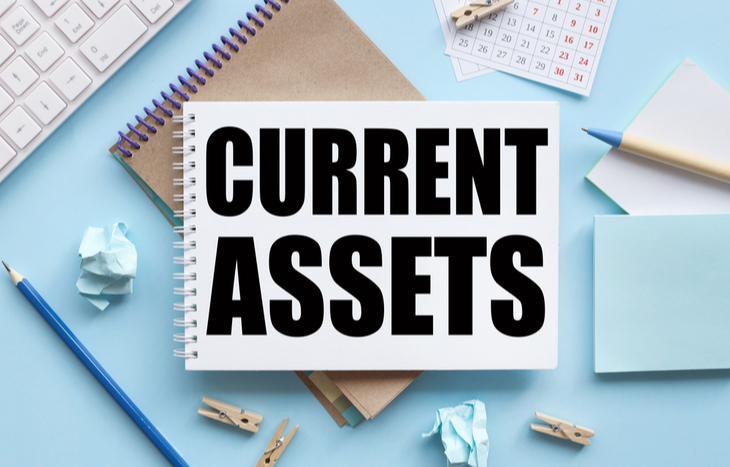What are Current Assets?

Companies rely on assets to help them generate revenue and become profitable. Some assets are long-term, while others are current. What are current assets? These are a company’s assets used in normal business operations and expected to be sold or used in less than one year. Specifically, these assets are a representation of the company’s immediate ability to pay its bills and sustain operations.
However, it’s a broad term that can encompass a wide array of valuable holdings. When evaluating a company’s current assets, it’s important for investors to understand these assets not only in terms of what they are, but their context alongside current and future liabilities.
Here’s a look at what they mean for a business, and how they factor into the company’s current position.

Types of Current Assets
A company can expect to use or sell its current assets within one year. This narrows the scope of assets to those that are more or less liquid. Some of the common types of current assets include:
- Cash. This is any cash-on-hand the company currently possesses.
- Accounts receivable. Funds owed to the company through credit it offers.
- Inventory. Products on-hand, waiting sales and the revenue that follows.
- Marketable securities. Debt or equity securities held by the organization.
- Prepaid expenses. Operational expenses paid ahead by the company.
To find a company’s current assets, simply look at the balance sheet. Keep in mind that these assets are only defined as such if they’re liquid at a fair market (or better) price within one year. The balance sheet will typically list current assets in order of liquidity. Cash appears at the top of the list, followed by cash equivalents, all the way down to prepaid expenses.
The Formula for Current Assets
Current assets show up as individual line items on the balance sheet. Nevertheless, there’s an equation for finding their cumulative value.
Current Assets = C + CE + I + AR + MS + PE + OLA
- C = Cash
- CE = Cash Equivalents
- I = Inventory
- AR = Accounts Receivable
- MS = Marketable Securities
- PE = Prepaid Expenses
- OLA = Other Liquid Assets
Again, this equation lists securities in order of liquidity. Not every type of asset is applicable for every company. To find the total value of current assets for a specific company, simply exclude those not present on the balance sheet.
Current vs. Long-Term
Current assets contrast long-term assets, which are generally illiquid and otherwise vital to long-term business operations. Long-term assets carry over from year to year and can include:
- Real property. Any land holdings owned by the company.
- Facilities. Any buildings or workplaces owned by the company.
- Technology. Technological assets that play a role in daily operations.
- Equipment. Equipment vital to the company’s value stream or production.
- Intellectual property. Trademarks, patents, copyrights and similar.
Long-term assets are illiquid and generally worth more to the company as assets than the value they’re saleable for. For example, a piece of equipment might sell for $300,000, but is responsible for producing products that result in gross revenues of $10M annually.
Ratios That Utilize Current Assets
Assets represent more than what they are—they represent opportunity. If the company’s debt’s came due tomorrow, would its assets cover them? If the sales pipeline suddenly shut off, how long could the company sustain operations? Companies and investors will ask these questions by looking at ratios, like the following:
- Current Ratio. Current assets, divided by current liabilities. It’s the gold standard for measuring a company’s ability to meet debt obligations and maintain operations.
- Cash Ratio. Cash and cash equivalents, divided by current liabilities. It represents a business’ ability to pay outstanding short-term liabilities off using cash on hand.
- Quick Ratio. Current assets (sans inventory), divided by liabilities. It’s the ability of a company to liquidate current assets to meet debt obligations.
These ratios (and others) shed light on the company’s liquidity and its agility in the event of operational disruption. They’re part of a thorough evaluation from the point of view of shareholders.
How do They Benefit a Business?
The availability of assets is what makes them useful. For example, cash-on-hand opens the door to numerous opportunities, such as the purchase of new equipment or the ability to pay down debt. Likewise, a company might decide to liquidate its investments to fund an acquisition, instead of taking out a loan and bringing more debt on to the balance sheet.
In fact, these assets give businesses options. Because they’re effectively cash equivalents, the business can use them in whatever capacity it needs to sustain, grow or diversify operations. Additionally, they don’t need to rely on debt funding or equity raising to do it.
How Does Depreciation Affect Assets?
When dealing with assets, companies frequently need to consider depreciation—as both a circumstance and an opportunity. Companies can divide the cost of an asset over its usable lifetime to depreciate it accordingly. Because of this, depreciation really only applies to long-term assets. A company will use or sell current assets within one year, meaning they’re not subject to depreciation.
What Do Current Assets Say About a Company?
Assets are always a good thing to see on a company’s balance sheet. Current assets shed light on a business’ ability to satisfy its upcoming debts and facilitate operations. Moreover, they’re an indicator for liquidity and, stacked against liabilities, paint a picture of a business’ health. Even though they’re sold or used within a year, these assets put a company in position to operate effectively—whether that’s investing in long-term assets or paying off debt to pave the way for a stronger balance sheet.
These data points are also a great way to recognize trends. To learn more, sign up for the Profit Trends e-letter below. The experts at Profit Trends analye the data for you and provid up-to-date stock tips and insights.






